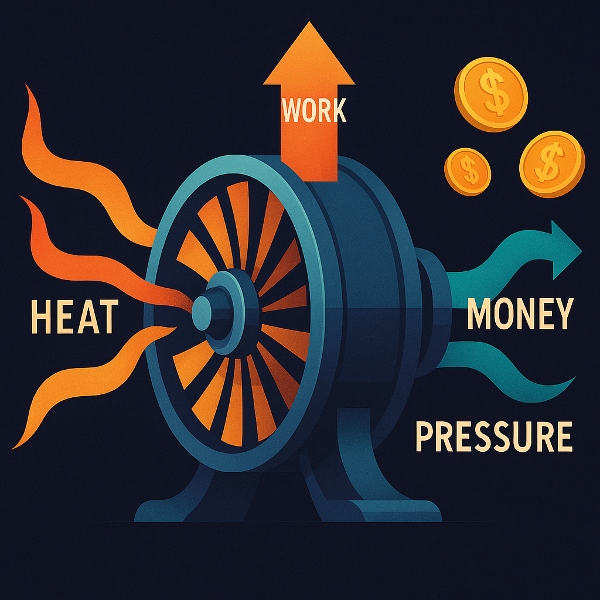
This is the biggest new insight.
In thermodynamics:
The same distinction exists among firms.
These firms:
Examples include:
They are “high-entropy generators.” They produce economic turbulence and create new industries around them.
They require “air-like” external financing: abundant, constant, and inefficient at cooling.
These firms:
Examples include:
Economically, they are cold, efficient, self-contained engines. They rely on a deep financial system to absorb their heat, but do not depend on it for working fluid.
Open-cycle firms power growth; closed-cycle firms power stability. A healthy economy needs both.
A heat engine cannot operate in a vacuum. It must release heat to an environment.
For locomotives, the surroundings are air—a poor coolant. That’s why locomotives are inefficient and need constant refilling.
For submarines, the surroundings are seawater—a powerful coolant. That’s why submarine reactors sustain a closed cycle indefinitely.
The economy works the same way.
The financial sector is the surroundings.
It:
If the surroundings are “air-like” (shallow financial system): firms cannot run closed cycles. They must burn capital and constantly seek new financing. The economy becomes volatile and inefficient.
If the surroundings are “water-like” (deep financial system): firms can run closed cycles, recycle capital, grow smoothly, and innovate. The economy becomes stable and scalable.
Banks are open-cycle engines in the environment. Banks:
They are open-cycle processors of environmental heat, just like industrial locomotives.
Now we come to a powerful conclusion:
Capital markets form because industrial firms release heat.
Every firm continually leaks heat:
Just as spilled heat in nature causes air currents, eddies, and vortices, spilled cash flows create financial flows, attracting:
And by the conservation of energy, that heat must go somewhere. It must produce:
Thus:
Capital markets are the natural thermodynamic response of the economic environment to the heat released by industrial firms.
Markets are not invented. They are condensers, coolers, and heat exchangers.
They arise automatically where enough heat flows exist.
What began as an analogy about stocks has grown into a thermodynamic theory of the entire economy:
And capital markets—far from arbitrary constructions— are thermodynamically necessary emergent structures, arising wherever economic heat must be absorbed and redistributed.
This completes the expanded picture that began with talk of stocks, gases, and temperatures.
ADVERTISEMENT
